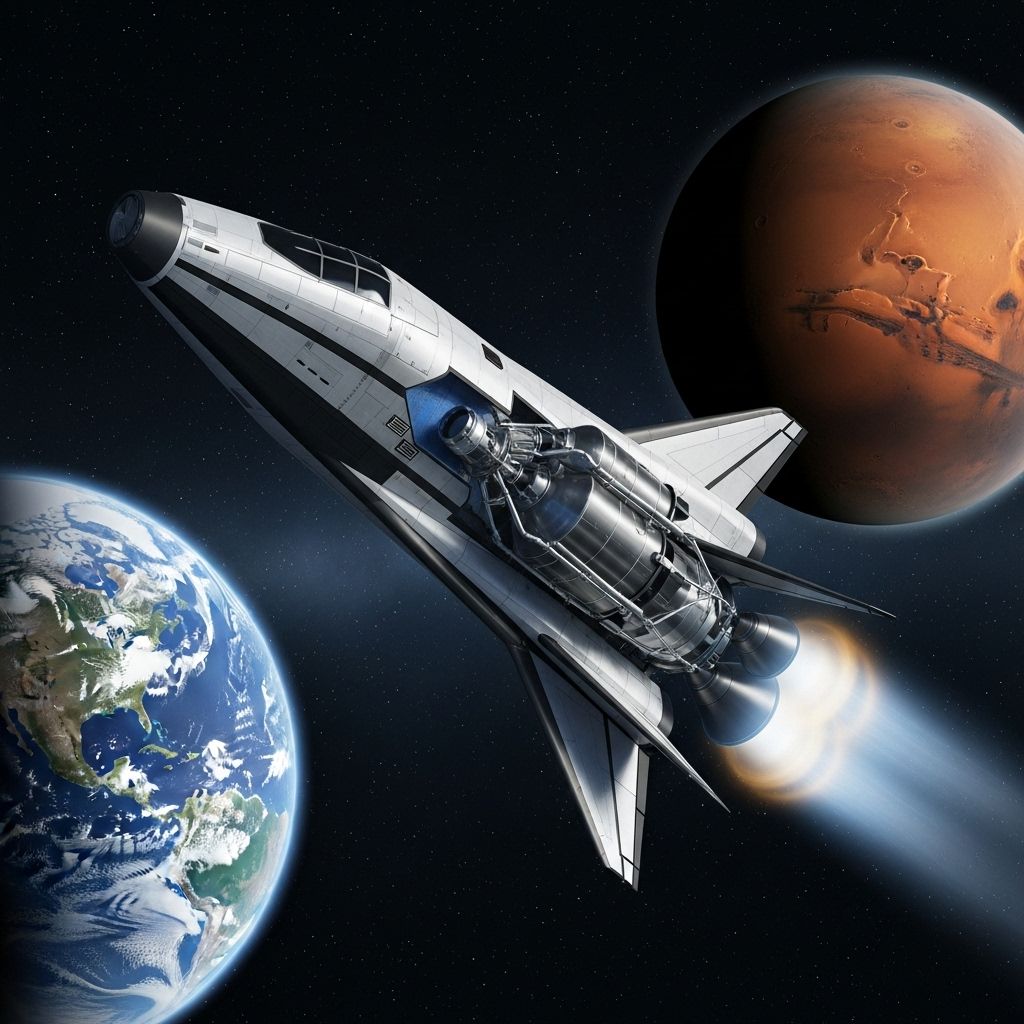Travel Time To Mars: 4 Propulsion Technologies For Faster Trips
Unpacking the science, technology, and challenges of humanity’s journey to Mars and what determines the time it takes to reach our neighboring world.

Image: HearthJunction Design Team
How Long Does It Take to Get to Mars?
The journey to Mars is one of humanity’s most ambitious space endeavors, blending complex celestial mechanics, advanced propulsion technology, and thorough mission planning. The time it takes to travel from Earth to Mars depends on a variety of factors, including the distance between the two planets, their orbital positions, and the type of propulsion system used. Let’s break down the essentials of Martian travel, explore past and future missions, and look ahead to what might shorten the trip in years to come.
Factors That Determine the Journey Time
There is no single answer to the question “How long does it take to get to Mars?” because several interdependent factors influence the duration:
- Orbital Mechanics: Earth and Mars both travel in elliptical orbits around the Sun. The distance between the planets changes constantly, from a minimum (called opposition) to a maximum (called conjunction).
- Distance at Launch: At their closest approach, Mars and Earth can be as near as about 34 million miles (54.6 million km), but more typically, in practical mission planning, launch opportunities occur when the two planets are ideally positioned, with distances ranging from about 34 to 250 million miles (54.6–401 million kilometers).
- Type of Propulsion: Different spacecraft use different engines, from conventional chemical rockets to advanced solar-electric or even nuclear propulsion systems. The speed and efficiency of the propulsion system significantly affect the travel time.
- Mission Design: The chosen flight path, such as the classic Hohmann transfer orbit versus more direct or complex trajectories, will also impact how long the trip takes.
Understanding the Distance: How Far Away Is Mars?
The average distance between Earth and Mars is about 140 million miles (225 million kilometers), but this number fluctuates widely:
- Closest Approach (Opposition): Approximately 34 million miles (54.6 million km)
- Farthest Apart (Conjunction): Up to 250 million miles (401 million km)
- Average Distance: Roughly 140 million miles (225 million km)
This variability is why launch windows for Mars missions are carefully chosen to coincide with periods when the planets are optimally aligned, which happens roughly every 26 months.
Historical Mars Missions: How Long Did They Take?
Several robotic spacecraft have journeyed from Earth to Mars, each mission timeline shaped by orbital positions and technology. Past missions offer valuable insight:
- Mariner 4 (1964): 228 days
- Viking 1 (1975): 304 days
- Mars Science Laboratory (Curiosity Rover, 2011): 254 days
- Perseverance Rover (2020): 203 days
These durations all fall between six and ten months, depending largely on chosen trajectory and launch timing.
Human Missions: NASA’s Plans and Projections
NASA is advancing ambitious plans to send humans to Mars as early as the 2030s. The projected duration for a crewed round-trip mission includes:
- Travel to Mars: About six to seven months (each way), covering up to 250 million miles (402 million kilometers) if Mars and Earth are at their maximum separation.
- Surface Stay: Up to 500 days on Mars, allowing astronauts to conduct science and exploration during the optimal window before return alignment with Earth.
NASA’s Artemis program, which will return astronauts to the Moon, serves as a steppingstone to practicing deep-space operations for a future Mars journey.
What Propulsion Technologies Influence Flight Time?
Reducing the trip duration is a major focus for engineers and mission planners:
- Chemical Rockets: The workhorse of spaceflight, these rockets use chemical propellants and are currently the fastest way we’ve sent spacecraft to Mars, but typically require six to nine months for the journey.
- Solar-Electric Propulsion: Uses electricity (typically solar power) to ionize and expel propellant at high speed. While this method is more efficient and can provide continuous thrust, it generally achieves lower acceleration and thus may not significantly shorten current trip times—yet future, higher-output designs are under development.
- Nuclear Propulsion: Nuclear Thermal Propulsion (NTP) and Nuclear Electric Propulsion (NEP) offer the promise of much higher efficiency and faster trips. NASA has indicated that nuclear systems could potentially halve the journey time, reducing exposure to cosmic radiation and other space hazards.
NASA Administrator Charlie Bolden has emphasized the agency’s desire to cut travel time in half, envisioning four-month missions with advanced propulsion.
The Role of Orbital Mechanics: Why Not Go Faster?
Reaching Mars isn’t just about speed—it’s about timing and precision:
- The optimal trajectory, called a Hohmann transfer orbit, is the most energy-efficient route, requiring roughly nine months for the one-way trip.
- Faster flight paths might be possible with more powerful engines but would require far more energy, increased fuel mass, and intricate trajectory planning.
- Spacecraft must also decelerate on arrival to allow orbital capture or surface landing, so the approach speed is a critical design consideration.
Launch windows—opportunities when Earth and Mars are properly aligned—occur about every 26 months and are vital for minimizing both travel time and energy consumption.
Risks and Challenges of a Long Journey
A lengthy interplanetary trip poses major engineering and human health challenges:
- Radiation Exposure: Prolonged time in deep space exposes astronauts to higher levels of cosmic rays and solar radiation than in low Earth orbit.
- Psychological Stress: Extended isolation, confinement, and distance from Earth require robust crew support strategies.
- Consumables: The longer the trip, the more water, food, and oxygen must be carried, increasing mission mass and complexity.
- Spacecraft Reliability: All systems—life support, propulsion, navigation—must function flawlessly over many months, with little room for error.
Could We Go Even Faster?
Emerging propulsion technologies and mission designs may eventually slash the trip length:
- Nuclear Thermal Propulsion: By heating propellant with a nuclear reactor, thrust could be doubled or tripled compared to chemical rockets, potentially making Mars accessible in about four months.
- High-Powered Solar Electric Propulsion: Advanced clusters of solar-electric thrusters could offer greater sustained acceleration, though technical challenges remain.
- Future Concepts: Theoretical propulsion methods, such as fusion drive or light sails, promise even faster travel but are still far from practical application.
Table: Travel Times to Mars by Propulsion Type
| Propulsion Type | Estimated One-Way Travel Time | Status |
|---|---|---|
| Chemical Rocket | 6–9 months | Used in all robotic missions to date |
| Solar-Electric Propulsion | 6+ months (potential for lower with high-power systems) | Demonstrated, advanced systems in development |
| Nuclear Thermal Propulsion | 4–6 months (projected) | In research and development |
| Theoretical Advanced Propulsion (fusion, light sail) | Weeks to months (theoretical) | Speculative/conceptual |
Frequently Asked Questions (FAQs)
Q: Can humans survive the long journey to Mars?
A: Yes, but only with significant shielding from cosmic radiation, psychological support, and reliable life-support systems. These are key areas of current research.
Q: What is the shortest possible trip to Mars with current technology?
A: Using the optimal launch window and fastest chemical rockets, the shortest credible robotic mission has taken just over six months. Crewed missions will likely take a similar or slightly longer duration depending on payload.
Q: Will future technology truly cut the travel time to four months or less?
A: Nuclear thermal propulsion and advanced solar-electric systems show promise for halving the trip time, but these require continued development and successful demonstration before routine use.
Q: Why can’t we launch to Mars at any time?
A: Mars and Earth must be correctly aligned in their orbits for optimal travel. These launch opportunities occur about every 26 months due to the planets’ relative motion.
The Future of Mars Travel
Humanity’s dream of reaching Mars is closer than ever, with crewed missions on the horizon and rapid technological progress underway. The time it takes to reach Mars will shrink as propulsion systems improve and mission design becomes more sophisticated. Still, the journey is always shaped by the laws of orbital mechanics and the realities of spaceflight.
Whether it takes six months, four months, or even less in future decades, the voyage to Mars remains a complex undertaking at the cutting edge of science and engineering—a steppingstone for humanity’s expansion into the solar system.
References
- https://www.space.com/how-long-would-it-take-to-walk-around-mars
- https://www.space.com/nuclear-rockets-could-travel-to-mars-in-half-time-designing-power-reactors-not-easy
- https://www.space.com/29540-manned-mars-mission-propulsion-technologies.html
- https://www.space.com/16875-how-far-away-is-mars.html
- https://www.space.com/nasa-wants-humans-to-mars-in-2030s-unlock-geologic-mysteries
Read full bio of medha deb











